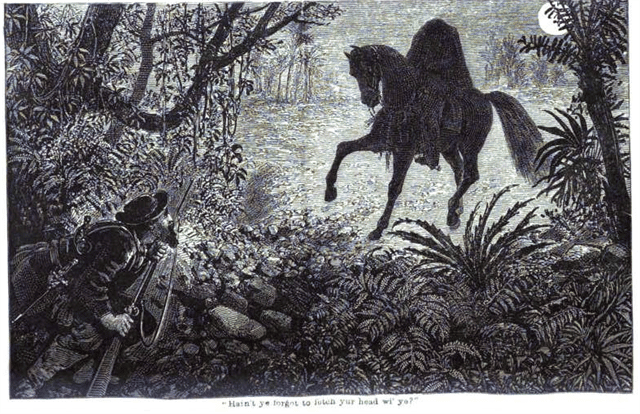When exploring Celtic folklore, chances are you’ll run into the Dullahan pretty frequently. Often considered one of the most terrifying figures in Irish mythology, the Dullahan is something you definitely want to stay away from.
The Dullahan (or “Dark Man”) is considered to be a dark fairy, particularly active in remote parts of Ireland. According to legend, the Dullahan is a harbinger of death who appears mostly during certain festivals and feast days.
Traditionally, this creature is depicted as a headless horseman, with his decomposing head in one arm and a whip fashioned out of a human spine in the other. His eyes are said to be lit by a hellish fire. His cloak and horse are darker than darkness itself.
Although the Dullahan is most often illustrated as a headless horseman, he’s also sometimes depicted as a headless man riding in a creepy black coach. This coach is known as a cóiste bodhar (or silent coach), which often accompanies a Banshee (link to).
The Dullahan’s coach is pulled by 4 (sometimes 6) black horses and some claim it even has a coffin mounted in the back. It doesn’t get more grim than that.

While a Banshee only warns people of their death, it’s said that the Dullahan is the one doing the killing. Interestingly, Banshees only target specific families, while the Dullahan can condemn virtually anyone to death.
The cóiste bodhar has been famously referenced in Thomas Johnston Westropp’s A Folklore Survey of County Clare. One of the most interesting tales in this book is the one describing the death of Sir Burton MacNamara, which was presumably caused by the Dullahan:
On the night of December 11th, 1876, a servant of the MacNamaras was going his rounds at Ennistymon […]In the dark he heard the rumbling of wheels on the back avenue, and, knowing from the hour and place that no ‘mortal vehicle’ could be coming, concluded that it was the death coach and ran on, opening the gates before it. He had just time to open the third gate and throw himself on his face beside it, at the bank, before he ‘heard a coach go clanking past. It did not stop at the house, but passed on […]the following day Admiral Sir Burton MacNamara died in London.
He rides his black steed through the countryside
and whenever he stops a mortal man dies.
He’s the Angel of Death and worthy of dread;
dressed all in black and lacking a head.
In his left hand is a spine that he’ll use as a whip.
In his right hand a scythe that will cut to the quick.
As the story goes, Irish villagers knew to run and hide in their homes when they heard the sound of horse hooves making their way through the forest. They also made sure to draw the curtains, as the sight of the Dullahan was blinding.
The Dullahan didn’t blind them with magic. Instead, he’d use his trusty spinal whip to whip the eyes out of onlookers.
The Dullahan is said to have limited speech capacities. He can only speak once on his journey, and this is to say the name of the person he’s going to kill. Once the name has been spoken, there’s no going back, that person has been marked for death.
He rides his black steed through the countryside
If you chance to observe him you may be struck blind
and still think yourself lucky that he left you behind.
If he pulls on the reins and he finds you outdoors
Your heart will stop dead and will beat nevermore.
There are buckets of blood where the Dullahan rides.
On all Hallows Eve you had best be inside.
The exact origin of this dark legend is unknown but he’s viewed as the incarnation of the Celtic god Crom Dubh, regarded as an evil deity in ancient times.
The ancient King Tigernmas (1621 - 1544 BC) was known for worshipping Crom Dubh. As part of his worship, it’s believed that Tigernmas normalized the decapitated human sacrifices that Crom Dubh demanded.

Being that Crom Dubh was the god of fertility, after the sacrifices were made, he provided bountiful harvests and plenty of healthy cattle.
When Christian missionaries came to Ireland during the 6th Century, they unsurprisingly banished the Emerald Isle’s pagan practices. This caused human sacrifices to wane, until eventually disappearing for good.
Deprived of his offerings, legend has it that Crom Dubh decided to take matters into his own hands. He took on the form of a headless horseman and began to claim the lives he was denied. With this transformation, the dark god became the embodiment of death itself.
However, some unfortunate villagers have claimed to have encountered the Dullahan on his way to kill. If you happen to stumble upon this cursed figure, he’ll hunt you down before proceeding to go take the life he meant to take in the first place.
So how do you defend yourself?
Once the Dullahan speaks your name, you are marked for death. Nothing can stop his command.
It’s said that carrying a gold coin in your pocket or wearing a piece of gold jewelry will send the Dullahan back where he came from. This will only work if you’re not the one he was after, though.
After scouring the internet, we encountered one anonymous account from the County of Galway, which establishes the Dullahan’s fear of gold:
“A man was on his way home one night between Roundstone and Ballyconneely. It was just getting dark and, all of a sudden, he heard the sound of horse’s hooves pounding along the road behind him. Looking around, he saw the Dullahan on his charger, hurtling towards him at a fair speed. With a loud shout, he made to run but the thing came on after him, gaining on him all the time. In truth, it would have overtaken him and carried him away had he not dropped a gold-headed pin from the folds of his shirt on the road behind him. There was a roar in the air above him and, when he looked again, the Dullahan was gone.”

If you’re thinking that your next trip to Dublin might be ruined because of the Dullahan, think again. This mythological creature is commonly tied to Northern Ireland, particularly County Sligo and County Down.
Interestingly, while in County Down, writer W.J. Fitzpatrick claimed that he encountered the Dullahan:
“I seen the Dullahan myself, stopping on the brow of the hill between Bryansford and Moneyscalp late one evening, just as the sun was setting. It was completely headless but it held up its own head in its hand and I heard it call out a name. I put my hand across my ears in case the name was my own, so I couldn’t hear what it said. When I looked again, it was gone. But shortly afterwards, there was a bad car accident on that very hill and a young man was killed. It had been his name that the Dullahan was calling.”
The Dullahan figure has inspired many tales and books, particularly, Washington Irving’s The Legend of Sleepy Hollow. Although the book is set in New York, it still represents certain aspects of Celtic tradition.
This St. Patrick’s Day, celebrate like it’s your last day on Earth. Watch Sleepy Hollow on Hulu and enjoy a nice cold pint of Guinness. You never know, you might be the next name on the Dullahan’s list.